
Meet the Teams
Over 300 teams from 32 countries have submitted innovative food system designs. 28 teams were awarded in Phase 1. Several new teams qualified to join the challenge in Phase 2.
31 teams remain.
Visit Impact Canada to learn about participating Canadian teams.
Meet the Continuing Phase 1 Teams.
ALSEC Alimentos Secos SAS
Antioquia, Colombia
Manufactured Foods. ALSEC proposes a food production system that includes the incorporation of four exponential technologies: microencapsulation, nanotechnology, artificial intelligence and 3D print for the formulation and development of natural, organic and highly nutritious powdered foods.
AMBAR
Bucaramanga, Colombia
Growth Systems. Agro-Migra is a multipurpose growing cabinet with different compartments that functions as an ecosystem, where both aquatic and terrestrial plants coexist generating food ready for consumption. Focuses on producing quality food, where the main objective is to achieve the well-being and satisfaction of the consumer.
Astra Gastronomy
San Francisco, California
Manufactured Foods. Growing, dehydrating and forming nutritious, fast growing microalgae into crunchy bite-sized snacks mixed with nuts and other ingredients will be a welcome change from traditional snacks found in space and on planet Earth.
Beehex
Columbus, Ohio
Manufactured Foods. A Universal Food Fabricator (UFF) that can dehydrate plants and cultured meats into powder form foods, store them into hermetically sealed cartridges to elongate shelf life (5+ years) and fabricate food using stored food in cartridges when needed.
Bistromathic
Austin, Texas
Manufactured Foods. Bistromathic is an automatic food production machine that ensures astronauts enjoy an Earth-like experience of eating during long space missions. It produces food with rich textures and appropriate moisture in different shapes and forms. Bistromathic is a robust and reliable food production technology that aims to provide nourishment for space exploration missions.
Enigma of the Cosmos
Brunswick, Australia
Growth Systems. Leafy & Microgreen Food production system with an adaptive growing platform using telescopic grow channel system to support plants natural growth cycle, increasing efficiency of the growing space by adjusting the grow area according to the plants needs and in return increasing the efficiency by a minimum of 40%.
Hefvin
Bethesda, Maryland
Bioculture / Hybrid. Hefvin grows fruit cells in nutrient rich media and uses spherification to encapsulate different cell types into an edible berry structure with skins and pulp. The technique produces berries rich in flavor, color and aroma.
Far Out Foods
Saint Paul, Minnesota
Growth Systems. The Exo-Garden is a nearly closed-loop self-contained food production system, which is capable of producing a variety of fresh mushrooms and hydroponic vegetables.
Interstellar Lab
Los Angeles, California
Growth Systems. NUCLEUS is a modular bioregenerative system that produces fresh microgreens, vegetables, mushrooms, and insects to provide micronutrients for long-term space missions. It combines several autonomous phytotrons to create a self-sustaining food production system that minimizes water, air, and nutrient inputs.
Kernel Deltech
Cape Canaveral, Florida
Growth Systems. The Kernel Food Production System is an autonomous device that produces an inactivated fungal biomass from well-defined starting materials. It achieves biomass production by using a continuous cultivation technique adaptable to low-gravitational conditions where the culture variables are tightly controlled to maximize biomass yield and product safety.
KEETA
Bangkok, Thailand
Bioculture / Hybrid. A 3D printed food system that utilizes output from an interdependence micro ecosystem to create varieties of nutrient rich food. The ecosystem is composed of producers, insects, and decomposers. The insects will be high in protein, vitamins and minerals, while also providing a wide variety of flavors.
LTCOP
Piracicaba, Brazil
Growth Systems. Produces fresh food (vegetables and fruits — strawberry and taioba) on Mars conditions and in transit. The vertical panels can be used to produce fresh food under artificial light and operational constraints. In this system, we can control plant nutrition with fertigation and fruit carotenoids levels adding terpene to the process. The tissue culture laboratory is included in the system to supply and maintain the germplasm bank.
Nolux
Riverside, California
Bioculture / Hybrid. An artificial photosynthetic system that is capable of producing plant- and fungal-based foods independent of biological photosynthesis.
RADICLE-X
Brooklyn, New York
Growth Systems. This lightweight, modular growing system is deployable in multiple habitats and greenhouse configurations and produces nutritious and variable fresh foods with maximum yields from minimal amounts of water, energy and astronaut time.
Solar Foods
Lappeenranta, Finland
Manufactured Food. Single-cell protein production by means of gas fermentation.
Space Bread
Hawthorne, Florida
Manufactured Foods. Space bread is a food system that allows astronauts to make bread in space. A multifunctional plastic bag allows crew members to store, combine, and bake all the ingredients in the bag to create a ready to eat yeast risen roll.
µBites
Carbondale, Illinois
Manufactured Food. A microbial-based next-generation food production system called μBites, which will utilize plastic and biomass waste as the carbon source for food generation.
Meet the New Phase 2 Teams.
Air Company
Brooklyn, New York
Manufactured Foods. Carbon dioxide exhaled by astronauts is captured from air and combined with hydrogen, and via water electrolysis, produces alcohol, which is then fed to a type of edible yeast that fully consumes it to make proteins, fats, and carbohydrates.
Arrakis Terrarium Project
Attleboro, Massachusetts
Growth Systems. A highly-efficient closed-loop growth and aquaponics system which produces high calorie root-based foods and animal protein.
Astro Cultivators
Northridge, California
Growth Systems. This autonomous space farming system grows self-pollinating crops in deep space missions, and significantly decreases crew time needed to operate plant growth systems by providing autonomous monitoring, real-time data reporting, ambient environment management, automatic harvesting, and cleaning.
Celestial Food Growers
Dekalb, Illinois
Bioculture / Hybrid. Celestial Food Growers intends to create a "tree of life" via their integrative approach to cell culture, wherein a network of self-contained growing chambers independently develop from a central growing branch.
Harvest Dynamics
Austin, Texas
Growth Systems. OptiFarm is a continuous growing system that autonomously manages lighting and nutrients and repositions plants throughout their growth cycle to minimize energy, water, labor and growing volume requirements. The system is modular and suited to grow many types of plants for space, lunar, remote, residential and microbusiness environments.
InFynity
Chicago, Illinois
Bioculture / Hybrid. InFynity produces high-protein, nutritious, delicious foods using microbial biomass grown in a novel bioreactor, which has been designed to operate both in space and on Earth in a sustainable way.
Mu Mycology
Hillsboro, Oregon
Bioculture / Hybrid. Forever Fungi is a closed-loop, modular, liquid media mushroom cultivation system that allows for continuous growth and harvest of various edible fungal fruiting bodies.
Mycorena
Gothenburg, Sweden
Bioculture / Hybrid. A highly-nutritious, complete fungal protein that feels and tastes like meat, with multifaceted space exploration potential including: A fully dry rehydratable format for easy transport; on-site low-gravity production possible through adapted bioreactors; and ability to use organic waste streams as carbon sources..
RAMA
Arlington, Virginia
Growth Systems. Rama stands for "Rotational Agronomics for Microgravity Automation". The method proposed is to utilize small scale enclosed spinning cylinders to simulate gravity environments for the cultivation of plants in space. Surrounding this base technology, a multi-phased approach of technology development and validation is proposed to develop automated systems for the cultivation and consumption of plants in microgravity environments. The technology is designed with efficient resource usage and minimal human interaction in mind.
SATED
Boulder, Colorado
Manufactured Food. SATED (Safe Appliance, Tidy, Efficient & Delicious) creates delicious browned foods derived from long-shelf-life and in-situ grown ingredients. SATED makes broadly customizable foods ranging from pizza to peach cobbler. The device is intrinsically fire and smoke safe and designed to operate in zero and low gravity environments.
Space Crickets
Landenberg, Pennsylvania
Manufactured Food. Easily configurable cricket habitats, interconnected with a vacuum collection system that operates in both zero gravity and terrestrial environments. The system produces hydroponic-ready nutrient solution from frass, and meal-ready full nutrition powder from crickets, and automatically maintains a clean, healthy environment, while humanely harvesting crickets by inducing low temperature hibernation.
Spacefarming Idaho
Boise, Idaho
Bioculture / Hybrid. The proposed platform is an autonomous, scalable, and high-efficient soilless growing system in space, which can be easily assembled with nearly no maintenance needed. Low water and energy consumption optimized by IoT sensors is another avenue being explored for monitoring and sharing environmental data between space and earth via satellite communications.
Strato.bio
Vilnius, Lithuania
Growth Systems. An autonomous symbiotic eco-system that cultivates fungi and vegetables together. The fungi-produced CO2 boosts plant growth by up to 30% on an earth-imitating enclosed ecosystem. This technology intends to produce constant medical / edible mushrooms and any vegetable yield no matter the external conditions.
Temple Green
Buffalo, New York
Growth Systems. An integrated food plant nutrient system which is compatible with both current and future indoor controlled growing environments, including production of a romaine plant containing 100% daily RDA — all the essential nutrients including vitamin D, to be readily absorbed by the body.
